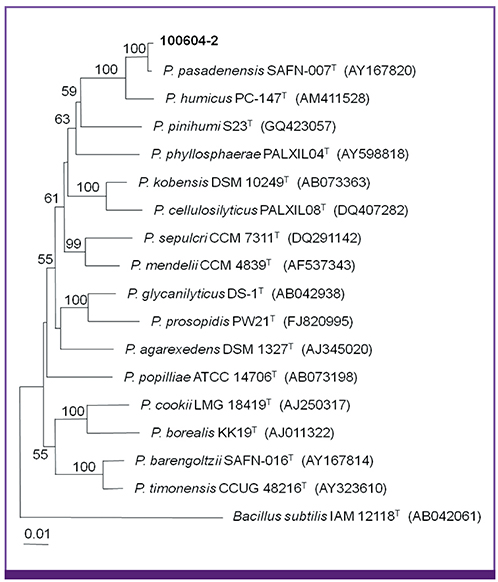Infect Chemother.
2015 Mar;47(1):64-67. 10.3947/ic.2015.47.1.64.
A Case of Paenibacillus pasadenensis Bacteremia in a Patient with Acute Respiratory Distress Syndrome after Microsurgical Clipping
- Affiliations
-
- 1Department of Infectious Disease, Eulji Medical Center, Eulji University School of Medicine, Daejeon, Korea.
- 2Department of Plastic and Reconstructive Surgery, Eulji Medical Center, Eulji University School of Medicine, Daejeon, Korea.
- 3Asia Pacific Foundation for Infectious Diseases (APFID), Seoul, Korea. ksko@skku.edu
- 4Department of Molecular Cell Biology, Samsung Biomedical Research Institute, Sungkyunkwan University School of Medicine, Suwon, Korea.
- KMID: 1909526
- DOI: http://doi.org/10.3947/ic.2015.47.1.64
Abstract
- We report the first case of bacteremia by a novel Paenibacillus species, Paenibacillus pasadenensis, from a 55-year-old male patient with acute respiratory distress syndrome, following a microsurgical clipping procedure of a ruptured intracranial aneurysm. The bacterium was identified using 16S rRNA gene sequencing analysis, which was applied because current conventional methods employed in the clinical microbiology laboratory proved unsuccessful. Since this bacterium was first identified in 2006 and has never been reported elsewhere, we believe this report can provide practitioners with useful insight on the pathogenicity of this species.
MeSH Terms
Figure
Reference
-
1. Ash C, Priest FG, Collins MD. Molecular identification of rRNA group 3 bacilli (Ash, Farrow, Wallbanks and Collins) using a PCR probe test. Proposal for the creation of a new genus Paenibacillus. Antonie Van Leeuwenhoek. 1993; 64:253–260.
Article2. Noskin GA, Suriano T, Collins S, Sesler S, Peterson LR. Paenibacillus macerans pseudobacteremia resulting from contaminated blood culture bottles in a neonatal intensive care unit. Am J Infect Control. 2001; 29:126–129.
Article3. Teng JL, Woo PC, Leung KW, Lau SK, Wong MK, Yuen KY. Pseudobacteraemia in a patient with neutropenic fever caused by a novel paenibacillus species: Paenibacillus hongkongensis sp. nov. Mol Pathol. 2003; 56:29–35.
Article4. Ko KS, Kim YS, Lee MY, Shin SY, Jung DS, Peck KR, Song JH. Paenibacillus konsidensis sp. nov., isolated from a patient. Int J Syst Evol Microbiol. 2008; 58:2164–2168.5. Roux V, Fenner L, Raoult D. Paenibacillus provencensis sp. nov., isolated from human cerebrospinal fluid, and Paenibacillus urinalis sp. nov., isolated from human urine. Int J Syst Evol Microbiol. 2008; 58:682–687.
Article6. Rieg S, Martin Bauer T, Peyerl-Hoffmann G, Held J, Ritter W, Wagner D, Kern WV, Serr A. Paenibacillus larvae Bacteremia in injection drug users. Emerg Infect Dis. 2010; 16:487–489.7. Al Masalma M, Armougom F, Scheld WM, Dufour H, Roche PH, Drancourt M, Raoult D. The expansion of the microbiological spectrum of brain abscess with use of multiple 16S ribosomal DNA sequencing. Clin Infect Dis. 2009; 48:1169–1178.
Article8. Chun J, Lee JH, Jung Y, Kim M, Kim S, Kim BK, Lim YW. EzTaxon: a web-based tool for the identification of prokaryotes based on 16S ribosomal RNA gene sequences. Int J Syst Evol Microbiol. 2007; 57:2259–2261.
Article9. Clinical and Laboratory Standards Institute (CLSI). Performance standards for antimicrobial susceptibility testing; twenty-first informational supplement, M100-S21. Wayne, PA: CLSI;2011.10. McSpadden Gardener BB. Ecology of Bacillus and Paenibacillus spp. in Agricultural Systems. Phytopathology. 2004; 94:1252–1258.11. Ouyang J, Pei Z, Lutwick L, Dalal S, Yang L, Cassai N, Sandhu K, Hanna B, Wieczorek RL, Bluth M, Pincus MR. Case report: Paenibacillus thiaminolyticus: a new cause of human infection, inducing bacteremia in a patient on hemodialysis. Ann Clin Lab Sci. 2008; 38:393–400.12. Kim KK, Lee KC, Yu H, Ryoo S, Park Y, Lee JS. Paenibacillus sputi sp. nov., isolated from the sputum of a patient with pulmonary disease. Int J Syst Evol Microbiol. 2010; 60:2371–2376.
Article13. Reboli AC, Bryan CS, Farrar WE. Bacteremia and infection of a hip prosthesis caused by Bacillus alvei. J Clin Microbiol. 1989; 27:1395–1396.
Article14. Bosshard PP, Zbinden R, Altweqq M. Paenibacillus turicensis sp. nov., a novel bacterium harbouring heterogeneities between 16S rRNA genes. Int J Syst Evol Microbiol. 2002; 52:2241–2249.
Article15. Roux V, Raoult D. Paenibacillus massiliensis sp. nov., Paenibacillus sanguinis sp. nov. and Paenibacillus timonensis sp. nov., isolated from blood cultures. Int J Syst Evol Microbiol. 2004; 54:1049–1054.
Article16. Wu YJ, Hong TC, Hou CJ, Chou YS, Tsai CH, Yang DI. Bacillus popilliae endocarditis with prolonged complete heart block. Am J Med Sci. 1999; 317:263–265.
- Full Text Links
- Actions
-
Cited
- CITED
-
- Close
- Share
- Similar articles
-
- Treatment of Acute Respiratory Distress Syndrome
- Clinical Manifestations and Diagnosis of Acute Respiratory Distress Syndrome
- A Case of Acute Respiratory Distress Syndrome Occurred after Pulmonary Edema in a Fullterm Newborn
- Acute Respiratory Distress Syndrome after Viscum album Pleurodesis for Primary Spontaneous Pneumothorax
- Respiratory Dynamics in Acute Respiratory Distress Syndrome


